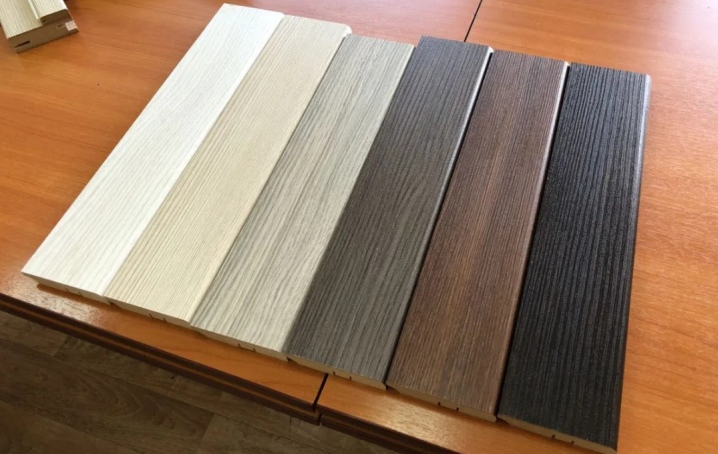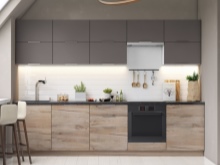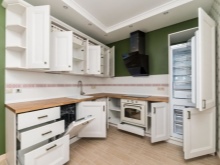All about eco-veneer

Innovative materials are designed to change the familiar for the better. For example, making furniture production environmentally friendly and cheap, and making the items themselves durable, durable and aesthetic. In this article, we will consider everything about eco-veneer.

What it is?
In an effort to create a material that mimics a wooden surface, manufacturers and laboratories are setting ever higher parameters for their work. Today, in addition to the cost of products, requirements are imposed on the safety of the material during operation, minimal environmental pollution, easy maintenance in everyday life, chemical and physical strength, and variability of use. These requests are answered by a group of materials, united by the name eco-veneer. They are similar in properties, but differ slightly in manufacturing technology. The name itself suggests that the eco-veneer should resemble a tree, giving the interior nobility and elegance.
Natural solid wood furniture has many disadvantages: expensive, heavy, subject to physical wear and tear, deforms, changes color, reacts to moisture, dryness and household chemicals. To make furniture beautiful, but less whimsical and demanding to the conditions, manufacturers have learned to make only a covering from wood. This is the veneer - the thinnest wooden sheets no thicker than 5 mm, demonstrating the beauty of the natural pattern, with which to cover other materials with them. So the production becomes cheaper, and the products themselves are much more durable in their qualities.


Eco-veneer is a plastic coating obtained under high pressure from several layers of film. It is a kind of finish for modern furniture that neatly hides the seams and joints. However, the process of creating an eco-veneer can hardly be called simple. Even the material itself consists of several bases, each of which gives the product certain qualities.


Advantages and disadvantages
Artificial materials have significant advantages that eco-veneers also have. The following characteristics play a decisive role when purchasing furniture:
- cost - products made of eco-veneer are more affordable than veneered or natural;
- have a relatively low weight, which simplifies transportation and installation;
- durable and wear-resistant - the coating is designed for certain physical activities: daily contact, touch, slight pressure, so abrasion stains do not appear on the eco-veneer, scratches are almost invisible; the coating is resistant to chips;
- moisture resistance - the film seals the materials inside the furniture, protecting them from excessive moisture; thus, the surface itself easily tolerates wet cleaning, and furniture coated with eco-veneer will be justified in rooms with high humidity - bathrooms, toilets, kitchens;
- variability of color - the coating convincingly copies any wood pattern, therefore, it will satisfy the wishes of aesthetes and fit into the budget; bold design solutions, bright or pastel colors can also be recreated in the interior with eco-veneer furniture;
- the coating does not fade from the sun, does not change color and is undemanding in terms of care;
- eco-veneer does not respond to changes in heat and cold;
- this material does not emit chemical compounds during operation, the quality of the eco-veneer is documented; furniture with a similar finish is suitable for installation in children's rooms and institutions specializing in working with children.


The disadvantages of the material are the flip side of the advantages, namely:
- low sound insulation - the film is too thin to drown out sound vibrations, so the reduction in noise effects will depend on other components of the furniture or doors;
- poor air exchange - the eco-veneer fits tightly on the base, leaving no gaps;
- with deep scratches and dents, the film will not be able to protect the base; such damage usually cannot be restored; the canvas will have to be changed.
The strength of the structure in most cases depends on the filling. Remember that eco-veneer is a film that successfully copes with daily loads, but is not fully responsible for the durability of the entire structure as a whole.


How is it different from other materials?
The market for products in the manufacture of which synthetic and artificial coatings are used is quite wide. Often, only the manufacturer understands the difference between these materials, while the seller is guided by his own interest. It turns out a situation when the buyer is forced to independently search for answers to a question or choose at random. It is worth considering in more detail what is the significant difference between eco-veneer and other artificial surfaces.
Now in everyday life there are several names for eco-veneer, which make confusion - euro-veneer and ultra-veneer. In fact, this is an eco-veneer, which contains wood fibers that create a special texture and recreate the pattern on the surface. It is difficult to distinguish them from wood, therefore these materials are not competitors among themselves. The main contender for the material is PVC.
If we compare products with an eco-veneer coating and PVC (polyvinyl chloride), then the only advantage of the latter will be the higher noise absorption provided by the product design. PVC is applied to MDF or chipboard boards, it is rarely hollow inside, while eco-veneer can keep its shape, closing and masking cavities, making the joints between materials invisible.


Eco-veneer outperforms PVC in the following positions:
- a variety of surfaces and patterns - eco-veneer imitates a complex wood pattern, the palette of colors and species is maximal; PVC products imply the most simple and concise design; bright glossy shine is provided by paint or enamel, if they are damaged, then the presentation of PVC disappears;
- environmental friendliness - under the influence of sunlight, PVC can change color and emit volatile compounds; such coverage is unsafe for humans;
- durability: on PVC, traces of damage will be more noticeable.
It is worth noting that you can independently notice the difference between the materials. Checking the cavities inside the canvas is quite simple: knock and listen for the sound. A loud and ringing knock indicates the manufacturer's economy, as well as low sound insulation. PVC products are completely smooth to the touch. Eco-veneer has a barely noticeable structure, especially if it imitates a wooden surface.


Views
Experts identify several types of eco-veneer. This classification depends on the composition and manufacturing technology of the film. Each case has its own preferences for use in the production of a particular furniture or industrial segment. There are five of them.

Wood fiber
This option is closest to natural wood. For manufacturing, the remains of wood are used, which are literally disassembled into fibers, give them the desired color, and then add a polymer to create a plastic mass. On special equipment - a double-belt press, the mass is passed in several stages until an ideal strong and flexible fabric is obtained from several layers. In this case, the layers become a single canvas without inclusions of air, dust, and other impurities. This is what provides a beautiful pattern, high durability and density of the material. The canvas is cut into sheets, rolled into rolls and already in this form is supplied to the furniture production. The only visual difference from wood will be a smooth knot-free surface - ideal for natural materials.


Based on polypropylene
This material is well studied by scientists and is recognized as one of the strong and versatile, its properties are transitional between flexible polyethylene and plastic that holds its shape. The propylene eco-veneer has a wide range of applications, therefore it is produced in different thicknesses - 0.15–0.35 mm. The multilayer material successfully replicates the roughness and woody pattern. At the same time, under different light and angles, the polypropylene film demonstrates a volumetric effect, creating beautiful overflows.

Pvc
Eco-veneer on the basis of PVC found itself in the production of door panels. To obtain the texture, embossing is used, for plasticity - additional bonds and polymers. The best quality in this segment is considered to be an eco-veneer made by German brands. Such a film is used for facing the simplest geometric shapes with minimal relief. PVC based films are more fragile during application. At low temperatures, the coating becomes sensitive to mechanical damage. This is especially noticeable at temperatures from -5 ° to -15 ° C.


From cellulose
Such a coating is considered to be the finishing one, it has the simplest manufacturing technology and an affordable price. Embossed and pre-applied wood grain cellulose sheets are treated with melamine compounds for moisture and scratch resistance. This coating covers the door leaves. Doors covered with cellulose eco-veneer can be found under the name laminated. They can be both flat and monochromatic, and repeating the woody texture.
Laminatin
This is a special durable option that is labeled as CPL or Continious Pressure Laminates. A multi-stage technology is applied here. Kraft paper is treated with resins with melamine or acrylic, which gives them special strength and anti-vandal qualities. Acrylic processing makes the sheets more plastic and durable. The layers are glued, dried in several steps, and then pressed to obtain a dense material. The final stages of the production of such an eco-veneer are embossing - the creation of texture and roughness characteristic of wood - and the application of a protective varnish.
For furniture covered with eco-veneer, a certificate of conformity is issued, which describes in detail the composition, technology features, coating characteristics and recommendations for care. Eco-veneer is characterized by low flammability and does not emit harmful substances under the influence of ultraviolet radiation, which means that it is safe. This material is preferred when decorating space in rooms for children.

Design
A special coating technology allows designers to use the widest possible palette. In this case, both laconic monochromatic shades and a rich spectrum of woody patterns can be used, which differ in patterns, saturation, contrast and effects. When creating an interior, experts strive to rely on the uniqueness of the room, but there are several general rules that will come in handy when choosing a color on your own.
- Traditional red, ocher and golden colors fits well into rooms where other objects made of wood or its imitations are present. Then the eco-veneer will not stand out against their background, while maintaining an elegant and natural look.


- Popular wenge will add contrast to rooms with a light interior, bright color spots. It will add more solidity and tradition. Such a dark color is good because in almost all palettes and samples it is similar in saturation.



- Light and ash shades make interiors expensive and chic. Especially good in this respect are shades close to bleached wood species - oak, beech and others. They give the impression of being real, antique and complement the atmosphere.



- Brown shades are classified as classic, gray and light shades are attributed to Scandinavian interiors and Provence style design. Saturated, dark and unconventional variations are often used to create modern and eclectic spaces.



Applications
Most quickly, eco-veneer found adherents among door manufacturers, since the coating, with its external nobility, is highly wear-resistant and ideally fits on the frame.

The moisture resistance of the coating made it attractive for the manufacture of furniture facades for the kitchen. Resistance to high temperatures, low flammability, resistance to alkalis and acids - these are significant advantages of the material, which housewives will be happy to appreciate.

Furniture covered with eco-veneer will be accepted in institutions serving children, since it has the necessary certificates. The absence of harmful fumes and compounds is a weighty argument when choosing children's furniture, since children are very sensitive to dangerous volatile compounds. Resistance to high humidity is an important quality for bathroom furniture. At the same time, eco-veneer can be used not only for facing panels, but also for finishing interior details, for example, skirting boards. It is precisely the compliance of the little things with the main style, their materials complete the atmosphere of the room and make it noble.

Manufacturers
Not all factories are ready to work with eco-veneer, since coating requires certain working conditions and skills of the craftsmen. Companies with strong positions in the market pay attention to this material. As a rule, they have a wide base of products, varied in style and color. Their buyers attach great importance to the ratio of price and quality, the appearance of the coating.
Among the factories producing doors from eco-veneer, Bravo, Volkhovets, the Italian-Russian project Profilo Porte, known as MariaM, Matadoor enjoy a good reputation. In their catalogs you can find doors of different designs: interior, entrance, blind, with glass inserts, folding, swing.


Certain models can be purchased from other well-known manufacturers: Verda, Krasnodrevshchik, Profile Dors, Rada, Sophia, Belwooddors.


Review overview
The opinions of buyers who have purchased and installed doors covered with eco-veneer are radically different. Everyone notes the beautiful design, elegance and natural appearance of the coating, but there is a lot of controversy about mechanical damage. Eco-veneer, like any coating, is sensitive to direct strong impacts and deep scratches.
Among the expert advice, the following important notes should be noted:
- other things being equal, when choosing a door made of eco-veneer or PVC, it is better to choose an eco-veneer; however, in practice, the door frame and its design are different, while buyers pay attention to the color and design, and not to the filling of the door;
- it is better to give preference to large or well-known manufacturers who give a guarantee for products;
- eco-veneer is an ideal material for bathroom, kitchen and interior doors;
- no structure will last long if exposed to excessive loads or gross mechanical damage;
- eco-veneer doors create a dead space and do not allow air to pass through, so the room needs to be ventilated more often;

Caring for such doors requires minimal effort: periodically wipe with a damp cloth or remove visible dirt. The protective coating eliminates abrasion of the layer and does not leave marks. This means that furniture or doors with an eco-veneer can also look great in a few years after purchase.

The next video tells about eco-veneer doors.













The comment was sent successfully.